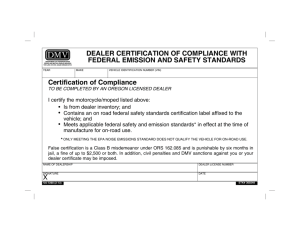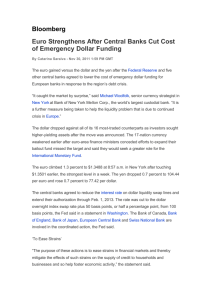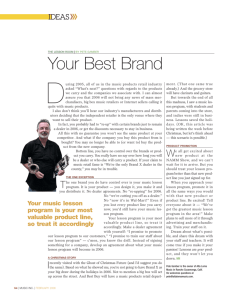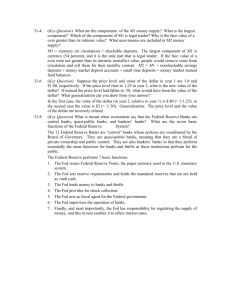Unification of the Segmented Foreign Exchange Market in
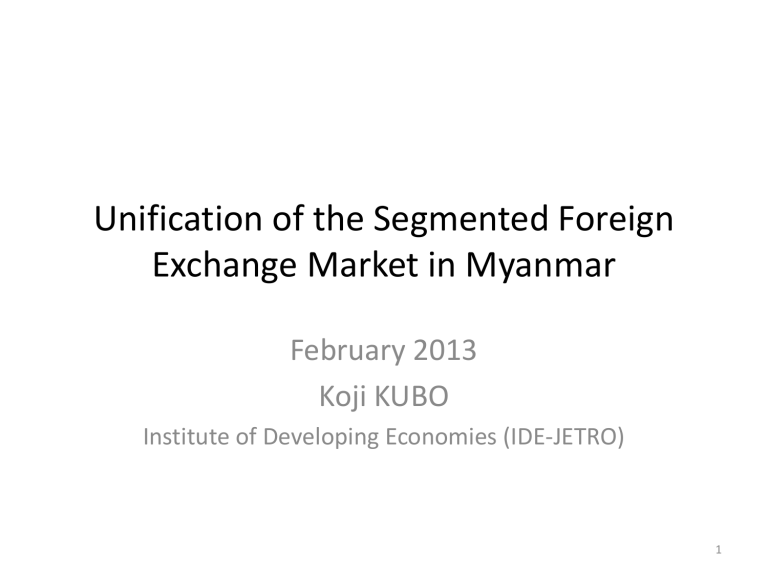
Unification of the Segmented Foreign
Exchange Market in Myanmar
February 2013
Koji KUBO
Institute of Developing Economies (IDE-JETRO)
1
Research Questions
• Does the move to a managed float exchange rate system in April 2012 signify the unification of the foreign exchange market?
• What are remaining challenges to establish the ground for exchange rate policies?
1. Transmission channel
2. Market instruments
2
Outline of Presentation
1. Unified foreign exchange market and segmentation: Benchmark case
2. Market structure before the reform
3. Reform and remaining challenges
4. Policy recommendations
3
Section 1
UNIFIED FOREIGN EXCHANGE MARKET
AND SEGMENTATION
4
1. Hypothetical benchmark: banks are in the middle. (1/2)
Central
Bank
Authorized
Dealer Bank
Interbank Market
Authorized
Dealer Bank
Authorized
Dealer Bank
Money
Changer
Household
Money
Changer
Household Exporter Importer
5
1. 1. Hypothetical benchmark: banks are in the middle. (2/2)
• Foreign exchange dealer banks as main counterparties
• Transmission channel of exchange rate policies
6
2. Causes of segmentation
1. Price (exchange rate ) controls
– Pegged rate and parallel rate
2. Regulations
– Regulations on the uses and sources of foreign exchange
• Ban on portfolio investment
• ‘export-first, import-second’ policy (export earnings and US dollar cash)
7
3. Why is segmentation a problem?
• Implicit tax on exporters and implicit subsidies on importers
• Price distortion and inefficient resource allocation
• Block transmission channel : Financial authorities cannot control all segments.
8
Section 2
MARKET STRUCTURE BEFORE THE
REFORM
9
Two segmentations in Myanmar
1. Between public and private sectors
– Official exchange rate in the public sector
– Parallel exchange rates in the private sector
2. Within private sector
– Conditionality of import licensing
• Export earnings (Foreign Currency Deposits)
• Dollar cash
• Foreign exchange certificate (FEC)
10
The gaps among export earnings,
US dollar cash, and FEC
1400
1300
1200
1100
1000
900
800
700
600
Cyclone Nargis
US dollar, dealer selling rate
FEC, dealer selling rate
FCD, dealer selling rate
Source: Japan External Trade Organization, Yangon Office
11
Transactions took place outside the banking system.
Formal
Exporters
State Banks
Account transfer of
FCD
Formal
Importers
Informal
Exporters
Payment in kyat
Illicit dollar
Informal
Importers kyat
12
Section 3
REFORM AND REMAINING CHALLENGES
13
1. Reforms under the new government
• October 2011: opening of money change counter
• November 2011: foreign exchange dealer license to 11 banks (later 14 banks)
• April 2012: move to a managed float system
– Daily announcement of Central Bank reference rate
– Auction of foreign currency with AD banks
• April 2012: abolition of ‘export first’ policy
• August 2012: permission of int’l banking services at private AD banks
• December 2012 : money changer license to non-banks
14
Mark-up of export earnings disappeared in May
2012, but there were some gaps among rates.
900
890
880
870
860
850
840
830
820
810
800
Parallel Rate (Money changer USD selling rate)
Exchange Counter (Bank USD selling rate)
CBM Reference Rate
FCD Rate (Broker USD selling rate)
FEC Rate (Broker selling rate)
Source: Japan External Trade Organization, Yangon Office
15
2. Remaining challenges (1)
• Segmentation between public and private sectors
• Segmentation within private sector
– Price gaps
– Large parallel market: Banking sector is not intermediating the foreign exchange transactions.
• Domestic account transfer and parallel market
• Limited transmission channel of exchange rate policies
16
2. Remaining Challenges (2)
• Underdeveloped financial market
– Limited instruments for sterilization
17
Sterilization instruments are limited.
Kyat cash is predominant in small financial market.
Source: IMF, International Financial Statistics
Note: CIC stands for Currency in circulation.
18
Section 4
POLICY RECOMMENDATIONS
19
Policy Recommendations (1)
Transmission mechanism
• Encourage exporters to sell their foreign exchange to banks
1. Stick: Tax on domestic account transfer of export earnings
2. Carrots: Discount market of L/C
3. CBM’s commitment to convertibility
• Larger intervention when necessary
4. People’s expectation on stable exchange rate
(when kyat is weakening, people do not release dollar)
20
Policy Recommendations (2)
Instruments for sterilization
• Banking sector development
1. Foreign currency deposits as a source of kyat deposits
2. Prohibition of foreign currency loans to prevent dollarization
21
Thank you for listening!
For inquiries and comments, e-mail to koji_kubo@ide-jetro.org
22
Appendix
TREND OF REAL EFFECTIVE
EXCHANGE RATE
23
Real effective exchange rate: appreciation exceeds 100%
↑ Appreciation
24

